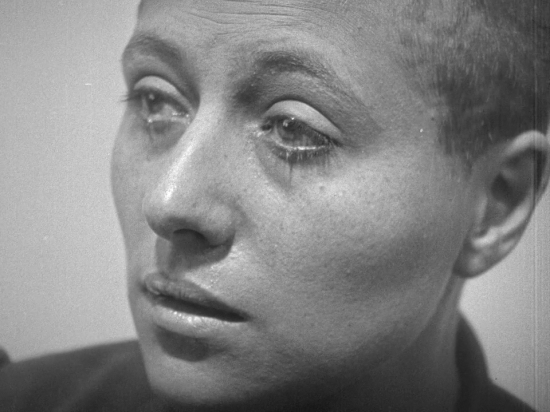
Now I think Anna Karina may be one of the coolest people ever put on film.
Last night I watched Jean-Luc Godard's Vivre sa Vie, which is a great film.
One thing I can definitely say about Godard, he had excellent taste in leading actresses. With both Jean Seberg in Breathless and Anna Karina in Vivre sa Vie, Godard has the rare kind of actresses who are beautiful and seem intelligent. I say "seem" because beautiful people often aren't very good at "giving" in the acting sense of the word. Being attractive seems to atrophy expressivity for a lot of people, even before the botox, creating an impression of dullness.
But that's not the case with Anna Karina, whose brain is right there in her gorgeous face, justifying the many lingering shots on her face throughout the film, self conscious, as usual, as the movie features a scene of Nana, Karina's character, at a cinema crying in close-up while watching La Passion de Jeanne d'Arc, Carl Dreyer's film focusing on a similar obsession with an actress's face.


Vivre sa Vie also features an excerpt from Edgar Allan Poe's "The Oval Portrait". In both cases, a connexion is drawn between the contemplation of someone's beauty and death. Which would seem to make sense in light of the downward spiral Nana's life takes, due, in part, to her beauty.

Vivre sa Vie prominently features prostitution, but it isn't really about prostitution in the way of Kenji Mizoguchi's film from a couple years earlier, Akasen Chitai, was, despite the fact that I see in Vivre sa Vie's Wikipedia entry that critic Jean Douchet says that Vivre sa Vie owes a great deal to Akasen Chitai. Akasen Chitai is more anthropological, more slice of life. It features a lot of very unobtrusive camera placements and lots of dialogue serving to make arguments through character biography. It's a film much more comfortable with the fact of prostitution than Vivre sa Vie, perhaps owing to Japan's greater mainstream familiarity with the institution than France (you can read what else I had to say about Akasen Chitai here).
Prostitution is more of a tool to illustrate something else in Vivre sa Vie, something less literal about human nature. A line I especially liked, early in the film, came from the husband Nana was leaving who was quoting from a child's essay he read the night before, "A bird is an animal with an inside and an outside. Take away the outside and the inside is left. Take away the inside and you see the soul."

Nana expresses a decidedly existentialist outlook on life, telling someone how everything she does is her choice. She wants to have more money, and be without the encumbrance of a family. At first she does this by moving quickly from one man to another, until finally her dedication to solitude leads her to prostitution. Perhaps Godard means to say the way that society and the government are set up makes this an inevitable route for a woman so isolated, though from this angle, Akasen Chitai is far better at discussing the actual reasons women become prostitutes. Which is not to say Nana's path isn't plausible, though the somewhat unusual circumstances of the end of the film diminish its usefulness as social commentary.
The experimental camera techniques Godard uses in his film carry off a fascinating simultaneous feeling of distance and intimacy. And urgency--a feeling of almost panic is created by dialogue scenes focusing on the backs of people's heads, while at other times Karina looks directly at the camera seemingly at random moments. Because she's so beautiful, and so "giving", you feel protective of her even as the rest of the time the movie is conveying a sense of sinister mystery.

In one scene, Karina comes across Godard's philosophy teacher in a cafe and the two discuss the difficulty, painfulness, and necessity of human communication. The scene reminded me of the scene in Alfred Hitchcock's Notorious where Claude Rains and Ingrid Bergman have a conversation at a restaurant table. In both scenes, the camera just continually cuts from one person's head to the other--"talking heads" as it's called, something comics artists and filmmakers generally aren't ever supposed to do. But in both cases, the technique works marvellously. Godard even goes a step further and doesn't include any shot of the two actors together. They may never have been in the same room at the same time, for all we know. It works, as in Hitchcock's film, because both heads are so fascinating.

No comments:
Post a Comment